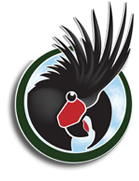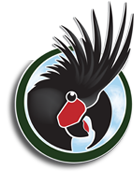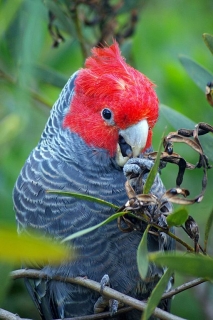Gang-gang Cockatoo |
|
|
Also known as: Red-crowned Cockatoo, Red-crowned Parrot, Red-headed Cockatoo, Red-headed Parrot, Helmeted Cockatoo
Photos
View in GalleryDid You Know?
The Gang-gang is one of only two cockatoos (the other being Major Mitchell's) with red anywhere on its head.Academic Research
Related publications: Callocephalon fimbriatumSpecies Profile
Genus: Callocephalon | Species: fimbriatum
Size:
33-35cm (12.8-13.6 in)
Weight:
240-330g (8.4-11.5 oz)
Subspecies including nominate:
one
Colour Adult:
Male-in general dark grey, the feathers scalloped pale grey/white; bright orange/red crest and head; secondary coverts suffused dull green; dark grey tail. Bill horn in colour. Eye dark brown. Female-dark grey head and crest; upperparts strongly barred with pale yellow, underparts heavily barred orange to green/yellow; undertail barred grey/white.
Colour Juvenile:
As in female but with more red in crest (male) and dark grey crest (female); crest shorter with less filaments; more evident barring on tail.
Call:
Described as croaking screech. Soft growling while feeding.
Listen NowVideo Links:
Video 1 | Video 2More Information:
Avibase
Article: Where's the Gang-gang Cockatoo?
Article: Call to help save Gang-gang Cockatoos as population declines by 69 percent
Content Sources:
CITES
BirdLife International
Cornell Lab of Ornithology/Birds of the World
NSW National Parks and Wildlife Service
Parrots: A Guide to Parrots of the World, Juniper and Parr, 1998
ML Media Collection Catalogue 4060, Gang-gang Cockatoo Callocephalon fimbriatum, Robinson, F., Australia, 1963, Cornell Lab of Ornithology. Site
Parrots of the World, Forshaw and Cooper, 1989. 2010 edition
Parrots of the World, Forshaw, 2006.
Parrots in Aviculture, Low, 1992.
Photos
View in GalleryDid You Know?
The Gang-gang is one of only two cockatoos (the other being Major Mitchell's) with red anywhere on its head.Academic Research
Related publications: Callocephalon fimbriatumSpecies Care
Captive Status:
Uncommon
Longevity:
60 or more years.
Housing:
Walk-in aviary, minimum length 4.5m (14.7 ft).
Diet:
Mix of small seeds: limited sunflower; walnuts, peanuts, pine nuts; fresh corn, fruit especially apple, hawthorn, cotoneaster and Pyracantha berries; complete kibble.
Enrichment:
Avid chewers so provide bird safe wood (fir), wood toys, vegetable tanned leather, pine cones; bathing.
Nest Box Size:
1m (3.3 ft) long nesting log.
Clutch Size:
2 to 3
Incubation Time:
28-30 days, as low as 25 days recorded.
Fledging Age:
8 weeks
Hatch Weight:
Not recorded.
Peak Weight:
Not recorded.
Weaning Weight:
Not recorded.
Photos
View in GalleryDid You Know?
The Gang-gang is one of only two cockatoos (the other being Major Mitchell's) with red anywhere on its head.Academic Research
Related publications: Callocephalon fimbriatumSpecies Wild Status
World Population:
Unknown, decreasing.
IUCN Red List Status:
Vulnerable
CITES Listing:
Appendix II
Threat Summary:
Habitat loss, increased susceptibility to psittacine cirovirus disease (PCD) virus and increasing bush fire activity. Recent research has discovered that in the last 21 years the population has declined by 69%, of which 10% was attributable to the 2019-2020 fire season.
Range:
Found in Australia from SE in E New South Wales through S Victoria to SE South Australia; introduced to Kangaroo Island.
Habitat:
Occurs in tall open forest in highlands and foothills; in winter to open woodland, riverine woodland, scrub, farmland and suburban areas. Up to 2000m (6560 ft).
Wild Diet:
Forages for green acacia, Pyracantha seeds, berries, nuts, fruits and insect larvae. Also Cupressus semipervirens, Liquidambar styraciflua, Acacia baileyana, A. mearnsii, Eucalyptus albens, E. bridgesiana, E. dives, E. melliodora, and Eucalyptus globulus globulus seed pods.
Ecology and Behaviour:
Nomadic; mostly found up in trees, only coming to ground level to drink; found in pairs or small family groups during breeding season; in winter larger groups up to 60.
Clutch and Egg Size:
2 to 3, rounded oval eggs, 36.0 x 27.5mm (1.4 x 1.1 in)
Breeding Season:
Nests October-January in tree cavity.
Related Links:
GANG-GANG OBSERVATIONS DURING THE 2020-21 BREEDING SEASON, CANBERRA, ACT
NSW Government: Gang-gang Cockatoo - vulnerable species listing
Photos
View in GalleryDid You Know?
The Gang-gang is one of only two cockatoos (the other being Major Mitchell's) with red anywhere on its head.Academic Research
Related publications: Callocephalon fimbriatumMembers Only Resources
Please log-in now to find more research, resources and tools.
Not a Member?
Find more great information:
Gain exclusive access to 600+ pages of additional research, seminars and podcasts, specialists to ask your toughest questions, and dozens of other fun resources - when you become a WPT member.
Join Today >>

































